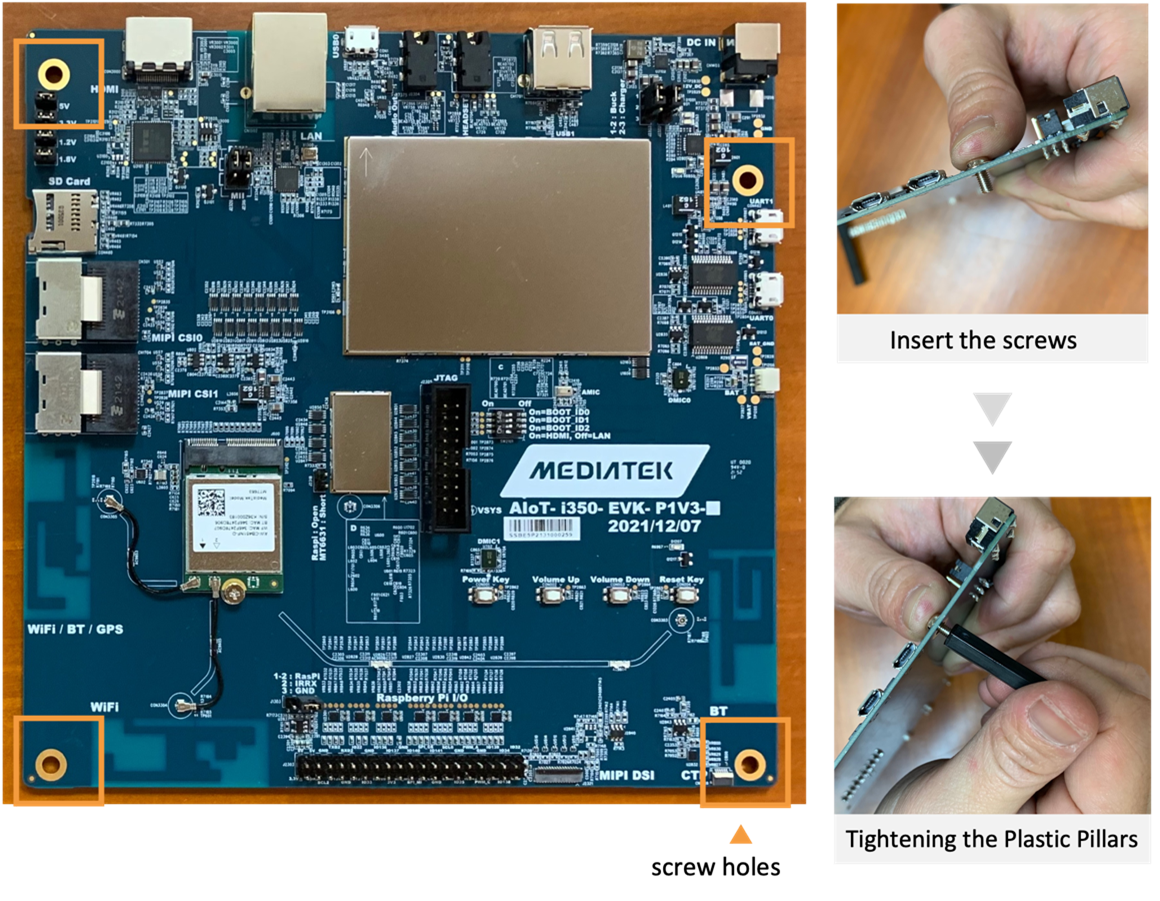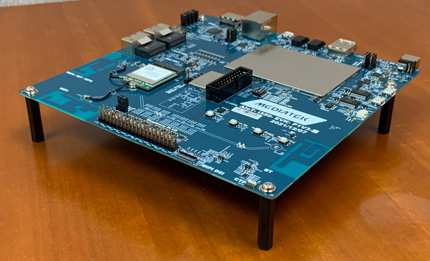Genio 350-EVK Yocto Demo
This demonstration kit is very flexible and can be setup in various configurations, with software support for Yocto or Android. However for the purpose of this Quick Start Guide, a specific configuration is chosen with the following conditions:
IoT Yocto software build
Both AP1302 ISP Camera Boards and Appletec AR0430 Camera Modules enabled
AP1302 ISP Camera Board configured to use the On-Semiconductor AP1302CSSL00SMGA0-DR ISP
External HDMI Monitor (not the included TFT LCD Module)
Ethernet interface disabled
Additional Items Needed for Quick Start Guide Demo
To support the demo, the following additional items are needed.
External Monitor supporting HDMI
HDMI Cable
Two USB Cables (USB-2.0-A to Micro-B)
External PC for loading flash and interacting via command prompt

Genio 350-EVK Yocto Demo System Image
Setup PC Environment
Install the Genio Tools on your Linux or Windows PC.
Kit Hardware Installation
Insert AzureWave Wireless Module and two corresponding jumper wires as shown in AzureWave Wireless Module. The jumper wires connect the module to the on board PCB antennas.
Insert Mini-SAS Cable into the corresponding connectors of the Genio 350 EVK mainboard and Camera board.
Connector locations can be referred to the marks in the picture as below.
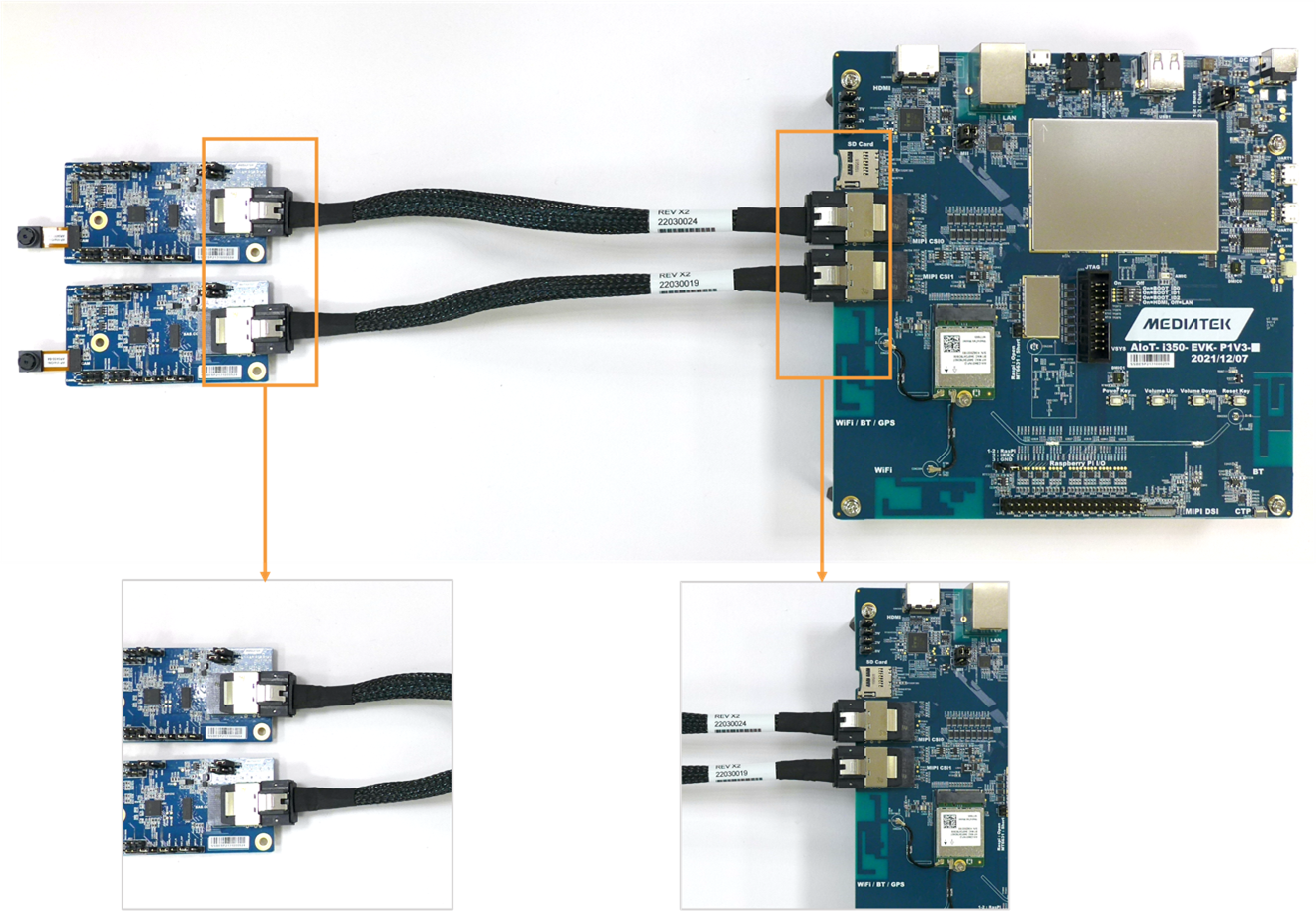
Camera Board Installation
Note
You should hear a “click” sound to confirm when the Mini-SAS cables have been correctly inserted into the connectors.
Insert the screws into the screw holes on the front of the Genio 350EVK mainboard and screw the plastic standoffs from the back.
Connect a USB cable to connector labeled UART0 as shown in: Genio 350 EVK Main Motherboard.
This requires installation of the Google Android USB driver as outlined in the Setup PC Environment section. If using Windows, open Device Manager and confirm that the driver appears under Android Device \ Android Bootloader Interface.
Connect a second USB cable to USB0
This requires installation of the FTDI VCP USB driver as outlined in the Setup PC Environment section. If using Windows, open Device Manager and confirm that the driver appears under Ports (COM & LPT) \ USB Serial Port (COMx), where x is the port assigned by your system.
Further details regarding both USB drivers can be found in the flash trouble-shooting section.
Plug AC/DC power adapter into the connector.
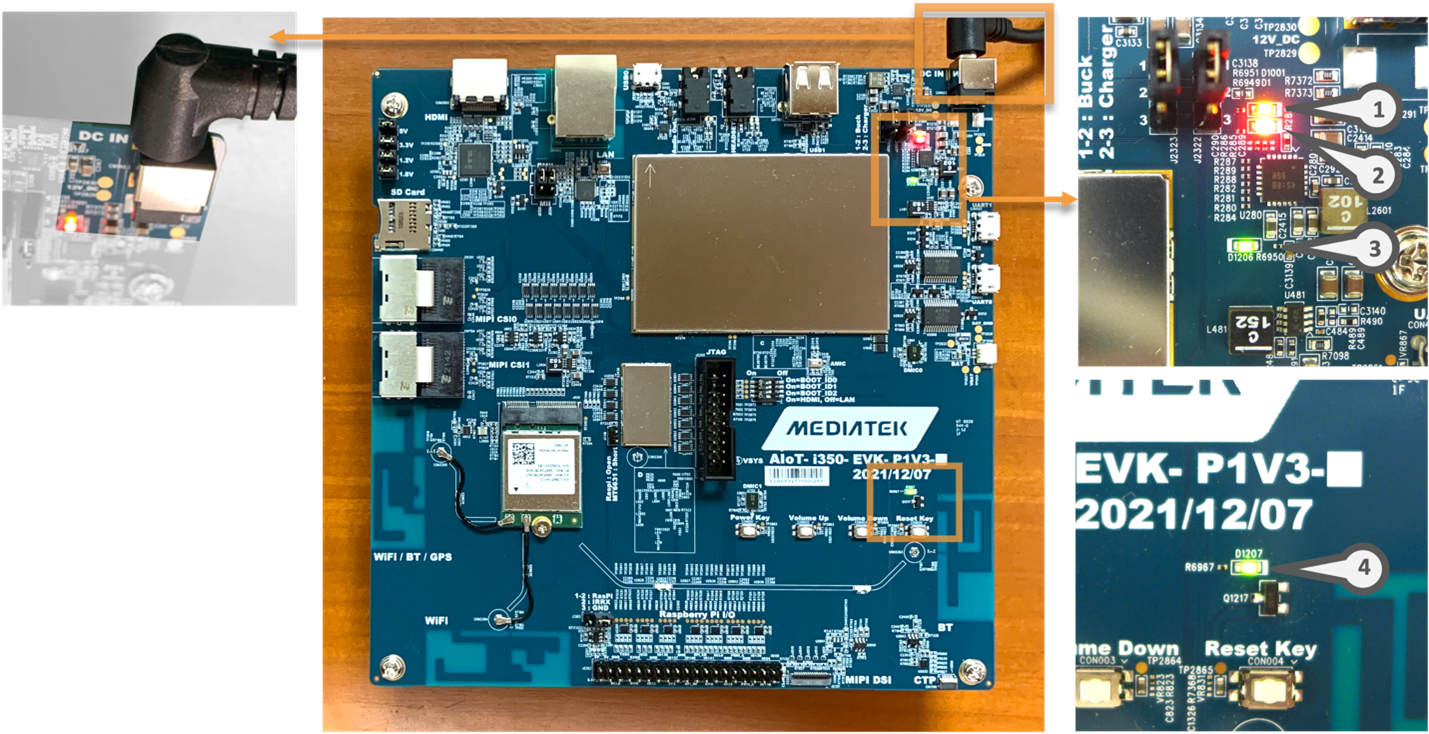
Power Adapter Installation
Note
After the EVK power is turned on, confirm that the four LED indicators illuminate.
Connect to the Serial Console
Setup the serial port for viewing debug output and interacting with the kit through a command line interface.
Check Device Manager that the USB COM port appears as a UART device under COM Ports
Configure your installed serial terminal emulator to use the serial port corresponding to the devices UART0 and operating with the baud rate set to 921600.
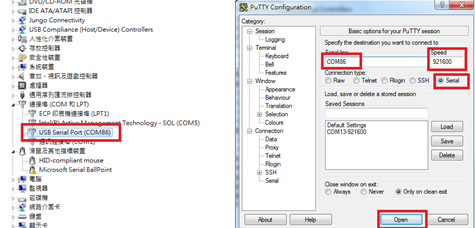
Example with Putty
Use dmesg to determine which USB serial ports have recently been connected:
dmesg | grep tty [299443.861514] usb 2-4.2.1: FTDI USB Serial Device converter now attached to ttyUSB0In this instance, the serial terminal is
ttyUSB0, which will be present under/dev/Connect to the device using a baud rate of
921600, for example, with Picocom:picocom -b 921600 /dev/ttyUSB0
Flash the Software
This guide shows how to “flash” (write) the demo image into the non-volatile flash memory of Genio 350-EVK. The flashing process is performed through the USB0 connection on the Genio 350-EVK. In order to write the on-board storage with Genio Tools, you need to set the IoT SoC in download mode, which allows Genio Tools to transfer a download agent binary to the SRAM of SoC. The download agent then provides a fastboot interface for subsequent image transfer and storage write operations.
Download the pre-built board image to your local PC.
Unzip the image.
Note
Avoid having a long path name by installing to a root folder and shortening the file name if necessary, for example C:\\evk.
Open a Windows cmd window (to enter commands)
Change working folder to the image directory before running the
genio-flashcommands:
cd C:\evk
View the Flash Image to Board instructions for further details or troubleshooting.
Flash the image using the overlay which enables both cameras. which enables Before flashing the board, check if there are certain board features you’d like to enable:
genio-flash --load-dtbo camera-ap1302-ar0430-dual.dtbo
Once you see the
Looking for a MediaTek SoC ...prompt, start the process to boot the board in flash download mode.
Press and keep pressing the volume up button
Press and release the reset button
Release the volume up button
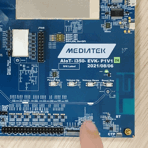
Reset the board to enter download mode
Note
On most Genio evaluation boards, the volume up button is connected to the KPCOL0 pin of the chip. If you have trouble finding the correct button, refer to the user guide or schematics of your board.
You should see flashing process started after releasing the volume up button. A typical successful log looks like this:
Genio Tools: v1.4
Yocto Image:
name: Rity Demo Image (rity-demo-image)
distro: Rity Demo Layer 25.0-dev (rity-demo)
codename: scarthgap
machine: genio-350-evk
overlays: []
Looking for MediaTek SoC matching USB device 0e8d:0003
Opening COM11 using baudate=115200
Connected to MediaTek MT8365 SoC
Sending bootstrap to address: 0x201000
Jumping to bootstrap at address 0x201000 in AArch64 mode
erasing mmc0
< waiting for any device >
Erasing 'mmc0' (bootloader) request sz: 0x3a6800000, real erase len: 0x0
OKAY [ 0.233s]
… (shortened for brevity)
Rebooting OKAY [ 0.002s]
Finished. Total time: 0.003s
Once the kit boots up with the new flash image, debug log messages can be seen through UART0 in the Putty terminal window.
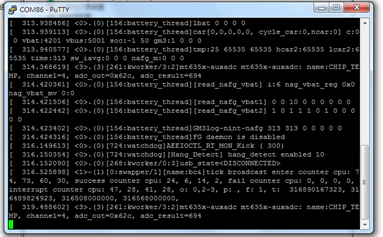
View of debug log messages appearing from UART0 upon board bootup
Verify the desktop screen appears as shown above in the image Genio 350-EVK Yocto Demo System Image
Log into board through UART0 interface.
Once board has fully booted, a login prompt is sent across UART0 similar to that shown below.
i350-evk login:
Type root, then enter, to login.
Camera Demo
The Genio 350-EVK Yocto Demo uses an imaging configuration using the Onsemi AR0430 and the Onsemi AP1302.
Camera Setup
Set jumpers on the AP1302 ISP Camera Board
There are six jumpers which must be configured as shown in the above figure of the AP1302 ISP Camera Board and Appletec AR0430 Camera Module.
Set camera properties with media-ctl command
Before using the cameras, you must set the resolution and the pixel format to 2316 * 1746, UYUV using the media-ctl command. The command requires several parameters, one of which is the media device of the sensor. The index of the media device may differ depending on the probing order of drivers and the number of devices. You can determine the index of the media device by typing the following command. In this example, the media device is /dev/media1.
ls -l /sys/bus/media/devices/ | grep seninf
lrwxrwxrwx 1 root root 0 Sep 20 2020 media1 -> ../../../devices/platform/soc/15040000.seninf/media1
Type the following commands to set the format of the MIPI-CSI 0 camera:
media-ctl -d /dev/media1 -V "'ap1302.2-003d':2 [fmt:UYVY8_1X16/2316x1746]"
media-ctl -d /dev/media1 -V "'15040000.seninf':4 [fmt:UYVY8_1X16/2316x1746]"
media-ctl -d /dev/media1 -V "'15050000.camsv':1 [fmt:UYVY8_1X16/2316x1746]"
Type the following commands to set the format of the MIPI-CSI 1 camera:
media-ctl -d /dev/media1 -V "'ap1302.3-003d':2 [fmt:UYVY8_1X16/2316x1746]"
media-ctl -d /dev/media1 -V "'15040000.seninf':5 [fmt:UYVY8_1X16/2316x1746]"
media-ctl -d /dev/media1 -V "'15050800.camsv':1 [fmt:UYVY8_1X16/2316x1746]"
Show Camera Images on the Screen
You must determine which device nodes are for the cameras. The video device nodes which point to seninf are the cameras.
In this example, the cameras are /dev/video3 and /dev/video4.
ls -l /sys/class/video4linux/ | grep seninf
lrwxrwxrwx 1 root root 0 Sep 20 10:44 v4l-subdev0 -> ../../devices/platform/soc/15040000.seninf/video4linux/v4l-subdev0
lrwxrwxrwx 1 root root 0 Sep 20 10:43 video3 -> ../../devices/platform/soc/15040000.seninf/video4linux/video3
lrwxrwxrwx 1 root root 0 Sep 20 10:43 video4 -> ../../devices/platform/soc/15040000.seninf/video4linux/video4
Using the video device nodes determined above, use the gst-launch-1.0 command to cause the cameras to display live video on the HDMI monitor.
gst-launch-1.0 v4l2src device=/dev/video3 ! video/x-raw,width=2316,height=1746,format=UYVY ! v4l2convert output-io-mode=dmabuf-import ! video/x-raw,width=400,height=300 ! fpsdisplaysink video-sink=waylandsink sync=false &
gst-launch-1.0 v4l2src device=/dev/video4 ! video/x-raw,width=2316,height=1746,format=UYVY ! v4l2convert output-io-mode=dmabuf-import ! video/x-raw,width=400,height=300 ! fpsdisplaysink video-sink=waylandsink sync=false &
You should see both camera images as shown below.
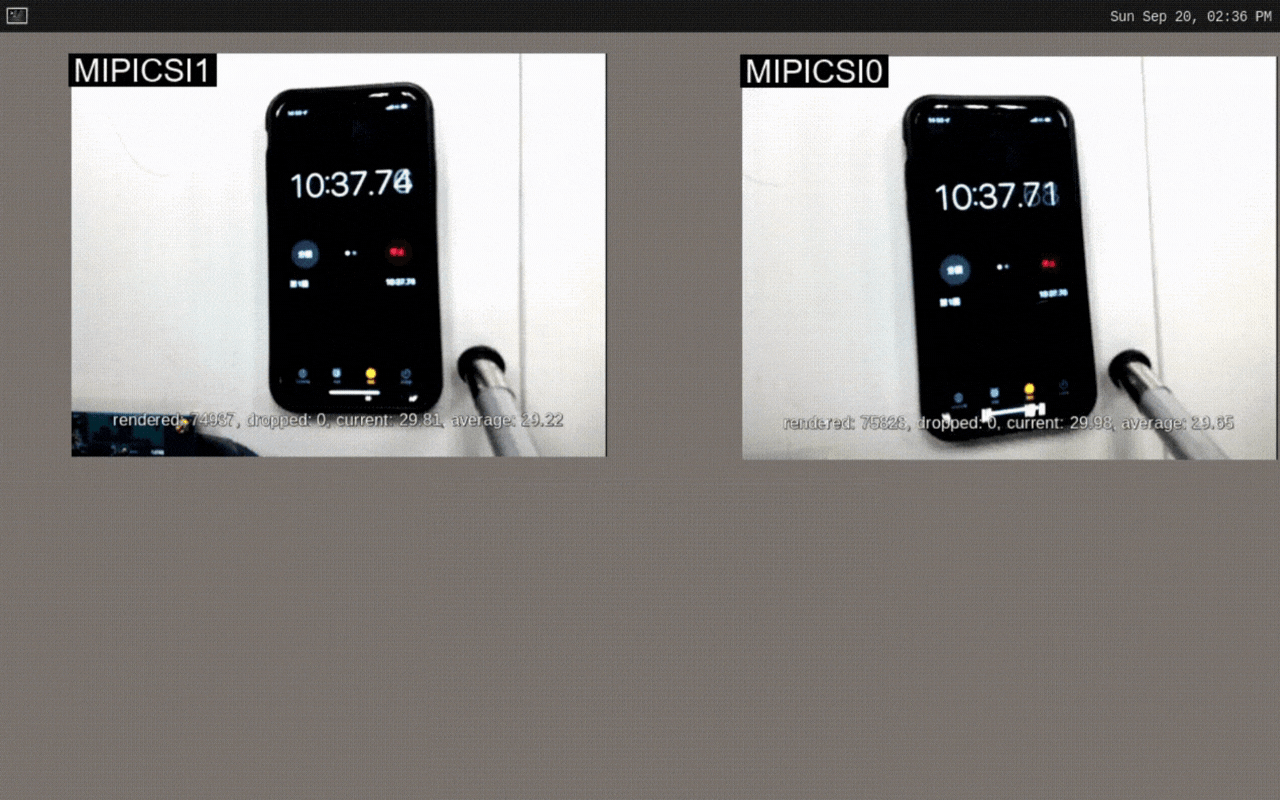
Multi-camera images using GStreamer
These commands are started in the background by using the ampersand symbol at the end of the command. To end any of these processes, you can type fg to place the process in the foreground, then CTRL+C to end it. Before proceeding to the next demo, type
fg CTRL+C
This kills the second camera process.
fg CTRL+C
This kills the first camera process.
Further details about hardware operation, background theory, or troubleshooting can be found in the BSP User Guide - Camera section.
GPU Demo
On IoT Yocto, there are several OpenGL ES applications that can used to check that the GPU is running and well integrated within the Wayland/Weston system. In this section we introduce two GLES applications: weston-simple-egl and kmscube.
They both use the GPU to render content, but they have different approaches to creating their graphic windows.
Display a Rotating Cube
This is a simple GLES program demonstrating how to drive bare metal graphics without a compositor (Wayland), using DRM/KMS, GBM, and EGL for rendering content using OpenGL ES.
After having typed CTRL+C from the above step, you should see only the simple desktop window which shows the date and time in the upper right hand corner. This desktop graphic is being driven by the weston service. In this demo, we will display a rotating cube by running the kmscube command. However kmscube will create its own window on which it renders content. So, before we launch kmscube, we must make sure that no other window system occupies the display. This means stopping the Weston process that drives the desktop.
Stop
westonservice if it already started.systemctl stop westonConfirm that the desktop disappears and you see only a dark screen on the HDMI monitor.
Launch
kmscubeand confirm that you can see a rotating cube as shown in below figure.kmscube
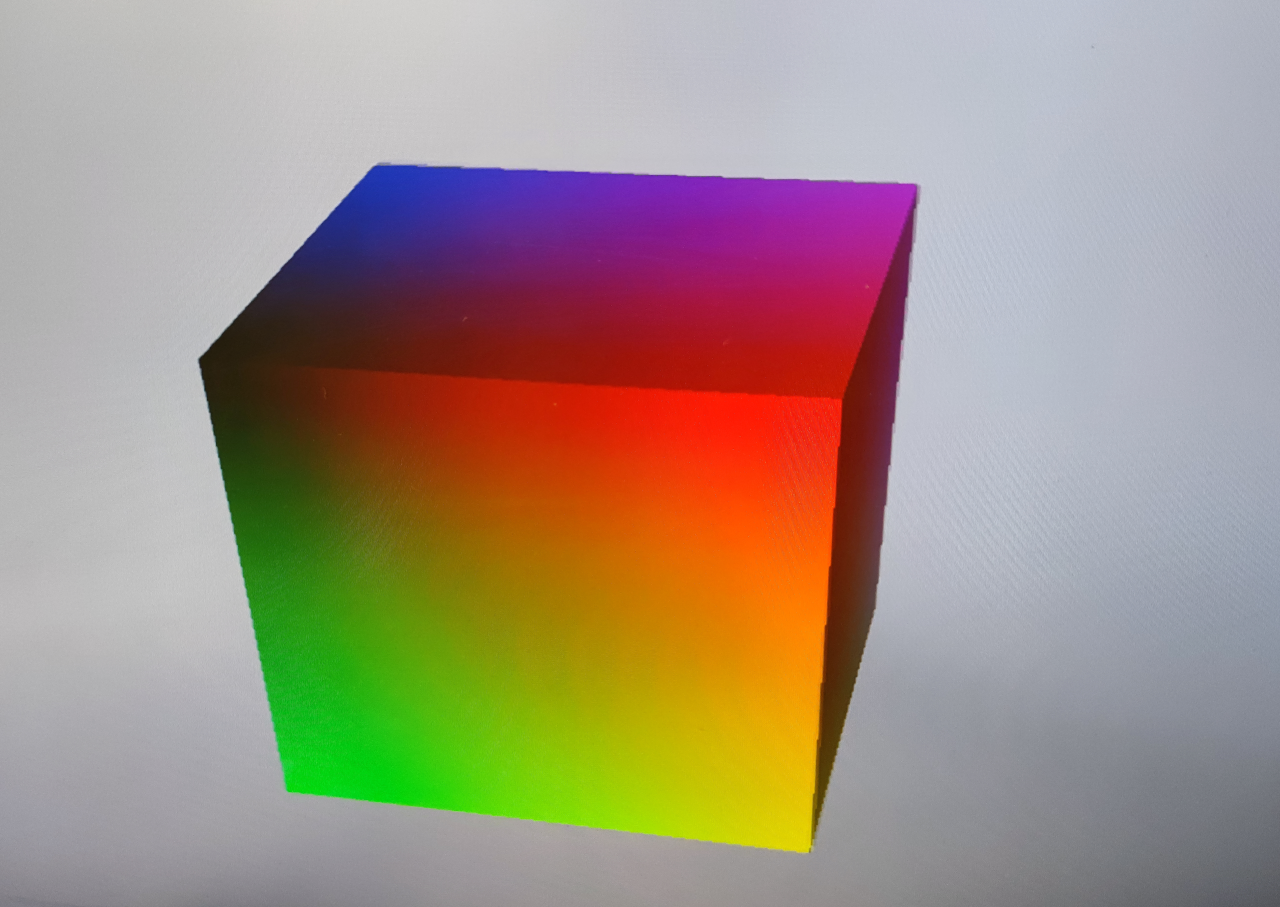
Screenshot of kmscube
Type
CTRL+Cto stop displaying the rotating cube.
Display a Rotating Triangle
This is a simple demonstration GLES program that draws a rotating colorized triangle on a transparent Wayland window. This program is not responsible for creating the window, and instead merely renders its content on an existing window which Weston creates. So, before launching it, we must start Weston.
Start
westonservice if it is not started yet.systemctl start weston@root.serviceConfirm that the desktop reappears which shows the date and time in the upper right hand corner.
Launch
weston-simple-egland confirm that you can see a rotating triangle as shown in below figure.weston-simple-egl 153 frames in 5 seconds: 30.600000 fps 150 frames in 5 seconds: 30.000000 fps ...
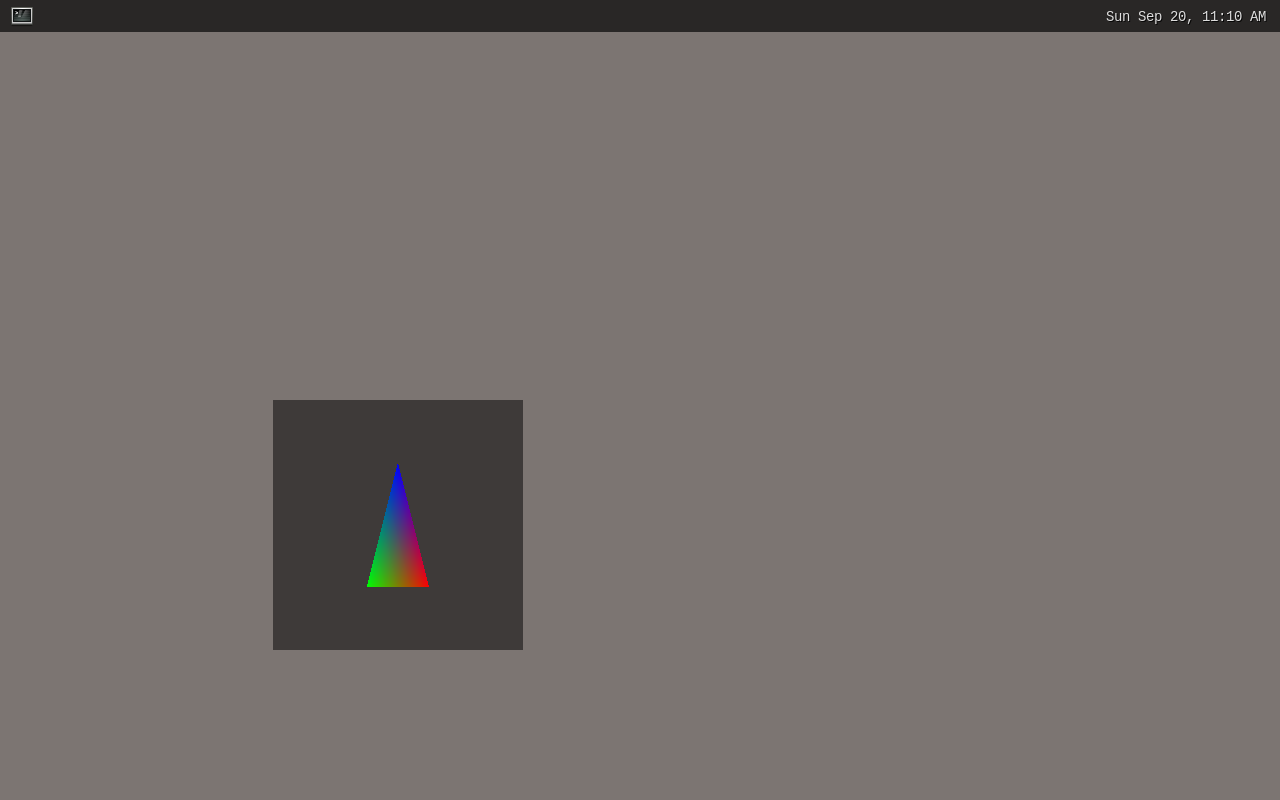
Screenshot of weston-simple-egl
Additional Details
You can find source code for weston-simple-egl in the Weston codebase: $BUILD_DIR/tmp/work/aarch64-poky-linux/weston/8.0.0-r0/weston-8.0.0/clients/simple-egl.c or weston github
You can find source code in Weston codebase: $BUILD_DIR/tmp/work/aarch64-poky-linux/kmscube/git-r0/git or mesa gitlab
Further details about the GPU, background theory, or troubleshooting can be found in the BSP User Guide - GPU section.
